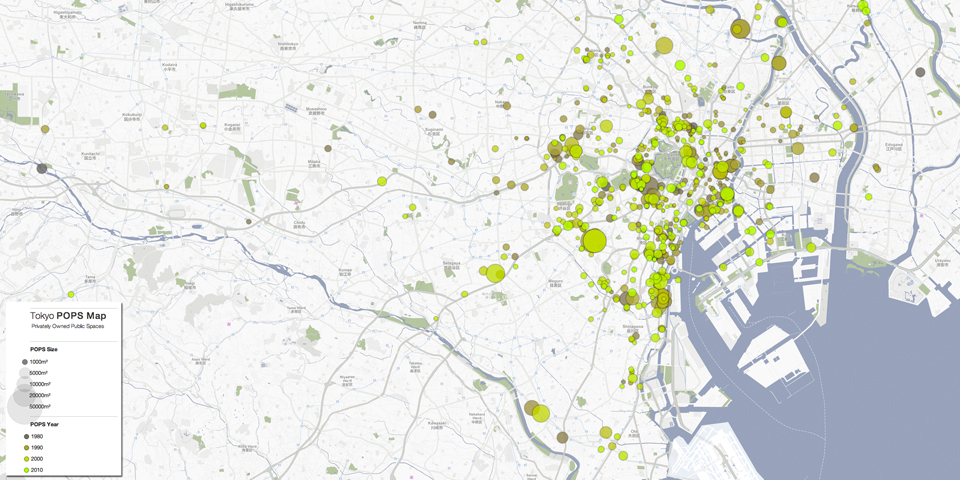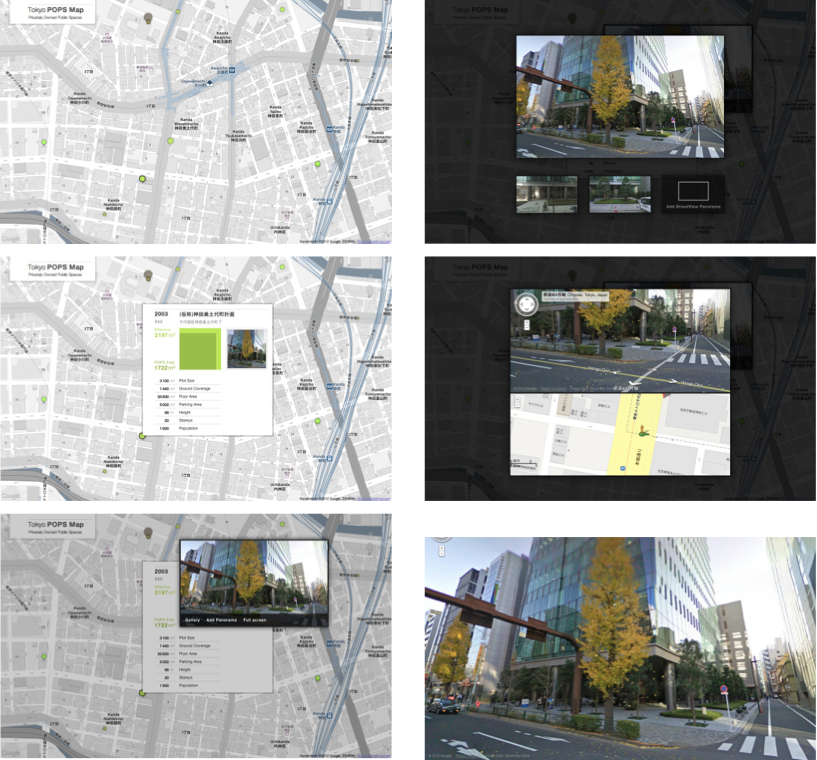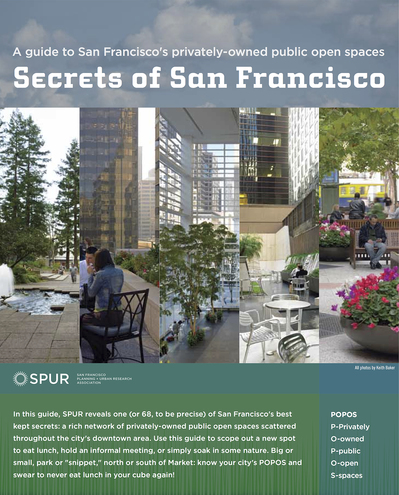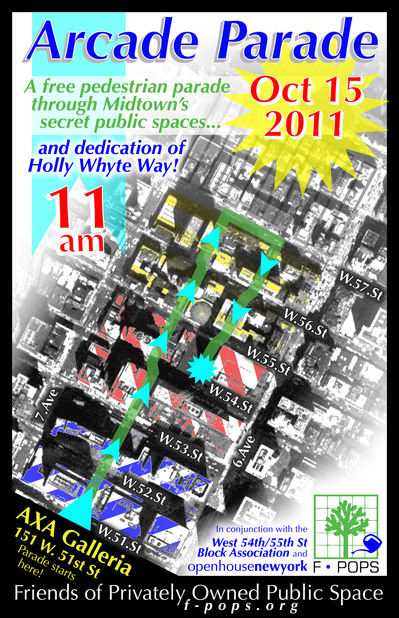Privately owned Public Space Project2010-2015
Privately owned Public Space Project
Please cite as follows:
DIMMER, C., “Out of Sight, out of Mind? Raising Awareness for Tokyo’s hidden Privately Owned Public Spaces”, in CENTER FOR SUSTAINABLE URBAN REGENERATION, THE UNIVERSITY OF TOKYO (Ed.) ‘D Catalogue - Planning & Design’, pp. 80-91, Tokyo, 2012
1. Introduction
The concurrence of the appropriation of Zuccotti Park by the ‘Occupy Wall Street (#OWS)’ movement in October 2011 and the 50th anniversary of the city’s ground-breaking zoning ordinance, both have drawn renewed, and unprecedented attention to a particular mode of urban governance that has not only brought this widely televised Lower Manhattan park into being but also hundreds of it’s like; not only in New York but across the world.
FIG.1: The San Francisco Planning and Urban Research Association (SPUR) has created a guidebook in order to bring the city's "best kept secret" -its 68 POPS- into public awareness (courtesy SPUR)
As the occupy movement spread around the globe and as other privately owned public spaces were similarly taken over by the protesters, such as Hong Kong’s iconic HSBC Plaza, Taipei’s 101 Tower, or City Square in Melbourne, so spread the awareness that such hybrid spaces at the nexus between public and private spheres existed also in many other countries and continents.
The occupation of Zuccotti Park and many other public places around the world as well as the peaceful revolutions in Northern Africa have thus highlighted once again the great importance of physical places for democratic, inclusive societies and stimulated a wealth of new academic writing on public space (See for example Shiffman et al 2012).
Not only academic urbanism discourses were invigorated by the implications of the political quality of public space, but these developments gave also rise to new, or existing grassroots’ projects that had been seeking to reclaim common spaces from privatisation and commercial commodification and that aimed at opening them again for the enjoyment of all members of the public (FIGURE 1+2).
FIG.2: Friends of Privately Owned Public Space are organising regular walking tours and events in order to heighten the public awareness of this urban asset (image courtesy of f-pops.org)
2. Research Rationale
One important prerequisite for active everyday use and appropriation of urban public space is that citizens are aware of which places belong to the public realm and which claims can legitimately made on these spaces. The creation of many so-called privately owned public spaces through private developers has been subsidised by city governments, who granted the right to build bigger buildings than would be otherwise permissible on the basis of current zoning stipulations. Although in turn these privately owned spaces have to be permanently open to all members of the public, their appearance is often private in nature and discourages a wider use. Bad maintenance, excessive control and commercial encroachment further frustrate everyday appropriation. Therefore, this research project pursues a triple strategy:
First, it wants to find out what the actual state of Tokyo's privately owned public spaces is. Where did these POPS materialise? Were they designed as usable spaces? How are they connecting to adjacent public spaces such as parks and promenades? How are they maintained and controlled? Is design and management attracting a broad use and are they identifiable as public places?
Second, the research aims at creating a comprehensive database as well as a crowd-sourceable map, through which the public awareness for POPS can be raised. The project seeks to activate civil society in order to secure proper access, prevent commercial encroachment and encourage more active use. Local governments in Japan are too understaffed to carry out more systematic, strict monitoring. Furthermore, Japanese cities are vulnerable to the frequent natural disasters, their population is rapidly ageing and public space is in short supply. If governments grant valuable subsidies to private actors for the provision of these public places under tense budgetary conditions, a proper monitoring of these deals has to be carried out and accountability has to be safeguarded.
Third, although local governments around the world are rewarding bonus floor area to private developers for decades if they in turn agree to produce and maintain publicly usable urban spaces, most research so far has only discussed these ‘privately owned public spaces’ (hereafter referred to as POPS), as Jerold Kayden coined them in his seminal book of the same title (2000), against the background of North American cities only. This research seeks to overcome this inherent Western bias by offering a first broad survey of governance systems that have been producing POPS in diverse Japanese cities such as Sapporo, Sendai, Tokyo, Yokohama, Nagoya, Kyoto, Osaka, Kobe, Kitakyushu, Fukuoka, and Hiroshima. Moreover, the project systematically relates these findings to similar developments in Santiago de Chile, New York, Seattle, Aachen, Bangkok, Taipei, Hong Kong, and Melbourne.
3. (Re)presenting POPS
The international comparison makes clear how differently POPS are treated by local governments, civic organisations and in public discourses. For example, also the casual visitor is initially greeted with easily understandable public plaza design principles when accessing the website of the New York City Department of City.(*1) These standards state that POPS have to be: a) open and inviting at the sidewalk, easily seen and read as open to the public, conveying openness through low design elements and generous paths leading into the plaza, visually interesting and containing seating; b) accessible and enhancing pedestrian circulation, located at the same elevation as the sidewalk; c) providing a sense of safety and security, containing easily accessible paths for ingress and egress, being oriented and visually connected to the street, well-lit; and d) providing places to sit and accommodating a variety of well-designed, comfortable seating for small groups and individuals.
Every citizen can understand these requirements that are further supplemented with well-presented graphical examples of good and bad POPS designs. Furthermore, the results of Kayden et al’s survey (2000) are presented in the form of a map and database on the homepage of the Department. Citizens can easily find here “the good, the bad and the ugly” privately owned public spaces.
On the website of the Tokyo Metropolitan Bureau for Urban Development(*2), on the other hand, only planning experts can find their way. Laypeople and ordinary citizens have no chance to understand the regulations, nor is the public amenity character of the urban spaces that result from incentive zoning openly and aggressively stated. In fact, other than abstract, technical design standards and a comprehensive list of developments utilising incentive zoning, little to no reference is made to quality of life or the importance of well-designed public spaces. Yet, another example is signage. While in New York a unified welcoming signboard design is mandated that states that the visitor is entering a public space and lists all the amenities to be found here, most POPS in Tokyo welcome visitors with a long list of non-permitted activities. In many cases it is extremely difficult to find such signage at all, as developers seek to conceal them. Even the Japanese term that is equivalent to POPS –Kokai Kuchi, or Public Open Space– is rather a technical term that is rarely understood by ordinary citizens. Instead of a list of available public amenities, members of the public are greeted by unintelligible planning jargon that describes on which precise zoning stipulations the provision of the space is based. New York’s unified POPS signage with the “broccoli” mark makes it clear that all spaces belong to larger POPS system, that makes up the city’s “decentralised Central Park.” In Tokyo, in turn, non-unified and hard to find signage as well as corporate logos and surveillance, often code POPS semantically as corporate spaces rather than public ones.
4. Facilitating collaboration
In Japanese urban planning discourses there are few other subjects that are equally well researched as privately owned public spaces, or 'kokai kuchi'. Since the early 1980s, around 200 academic research projects have dealt with incentive zoning, and POPS in one way or another.
Yet, this enormous body of research has had little impact on the design, management and use of these urban spaces. While public research repeatedly played a crucial role to reform planning regulations in New York City and to turn these once barren expanses of concrete into friendlier "people places", research in Japan had only little impact on the actual planning and building practice.
The mapping of Tokyo's privately owned public spaces serves in this respect the purpose of facilitating more systematic, continuous research on the subject that has a stronger impact on the design, management and use of POPS.
By creating a semi-public Google map that is shared with collaborating POPS researcher in and outside of academia, a new open working platform is created that provides common ground. Collaborators have access to the latest data and, in turn, are able to add layers that present their own research findings.
Map and database are therefore continuously expanding the knowledge on POPS and hold all the available information that is helpful for new evolving research projects on the subject.
 FIG.3: Visualisation of location, year of construction, and relative size of 694 POPS in Tokyo that have been created by the utilisation of the Comprehensive Design System between 1976 and 2011, and government by the metropolitan design standards. Not shown in this map is an unknown number of POPS that have been created under the permission standards of the 23 wards. (Adapted from Google Maps, by Jan Lindenberg, IIDJ & Christian Dimmer)
FIG.3: Visualisation of location, year of construction, and relative size of 694 POPS in Tokyo that have been created by the utilisation of the Comprehensive Design System between 1976 and 2011, and government by the metropolitan design standards. Not shown in this map is an unknown number of POPS that have been created under the permission standards of the 23 wards. (Adapted from Google Maps, by Jan Lindenberg, IIDJ & Christian Dimmer)
5. Raising public awareness
A second, equally important, purpose of the map is its function as awareness raising tool for the general public. Like in San Francisco (Fig.1) and New York (Fig.2) citizens will be able to identify the nearest POPS, see which recreational activities can be carried out there –if any– and know how the space should be maintained and controlled. If the actual condition of these spaces does not corresponds to what is stated by developers, or local governments, members of the public are able to upload own pictures and comments on each of Tokyo's POPS.
 FIG.4: Based on the detailed survey a database is being created that will visualise the location and design details of every of Tokyo’s POPS. The map is crowd-sourcable and every citizen will be able to add additional pictures and submit comments. (Based on Google Maps, by Jan Lindenberg, IIDJ)
FIG.4: Based on the detailed survey a database is being created that will visualise the location and design details of every of Tokyo’s POPS. The map is crowd-sourcable and every citizen will be able to add additional pictures and submit comments. (Based on Google Maps, by Jan Lindenberg, IIDJ)
This in turn promotes better accountability and good governance, as the public is made aware of bargaining processes behind incentive zoning and is becoming more sensitive to the design quality of these public spaces that have been created in turn for a growing number of larger, bulkier buildings. The tool can also help local governments with the monitoring of design and management.
Tokyo’s best kept secret –its over 800 POPS that taken together are equal in size to 12 times the area of Hibiya Park– will thus no longer be hidden; no longer out of sight and out of mind, because of a raised awareness and more intensive use.
(Christian DIMMER, Ph.D.)
[Notes]
*1 Website of the New York City Department of City Planning
*2 Website of the Tokyo Metropolitan Bureau for Urban Development
[References]
Kayden, Jerold S., The Municipal Art Society of New York, and The New York City Planning Department of City. 2000. Privately Owned Public Space: The New York City Experience. Wiley.
Shiffman, Ron, Rick Bell, Lance Jay Brown, and Lynne Elizabeth. 2012. Beyond Zuccotti Park: Freedom of Assembly and the Occupation of Public Spaces. New Village Press.
SPUR, San Francisco Planning + Urban Research Association. 2009. A Guide to San Francisco’s Privately-owned Public Open Spaces. San Francisco.












